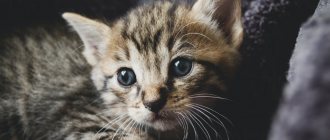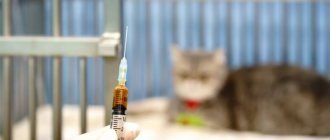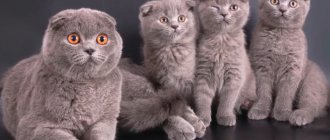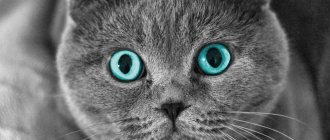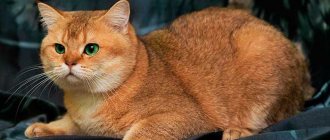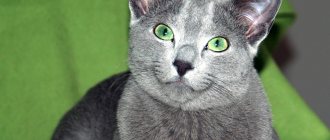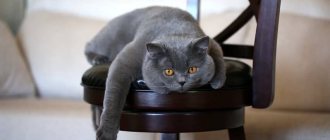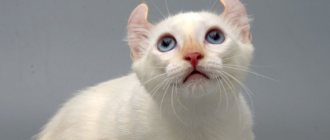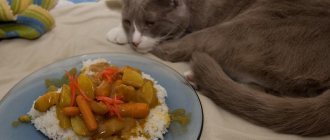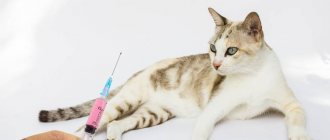Scottish cats delight with their toy appearance; they are welcome pets in many homes. The majority of Scottish cats are healthy and immune-strong individuals. However, owners need to know what diseases occur in Scottish cats in order to diagnose them in time and send their pet to a doctor for treatment.
But even if no symptoms are observed, a visit to the veterinarian for preventive purposes will not hurt.
Main types of diseases among Scots
In many ways, the health of the Scottish Straight depends on the cat's nutrition. Also, the owner should pay attention to the appearance of the fur and the cleanliness of the tear and ear canals. Most diseases in Folds occur due to a mutation that affects not only the shape of the ears. But straight-eared Scots, like other breeds, have no fewer possible diseases.
A kitten's dry nose may indicate a problem; however, it may be due to physiological reasons. During sleep or after, in a hot room this is normal. If your kitten has a dry nose, measure its temperature; an elevated temperature indicates the presence of a virus. The acceptable temperature for cats is about 38.5 degrees.
Diarrhea and vomiting can cause dehydration, which will also result in a dry nose. Diarrhea is caused by a change in food, intolerance, parasites, and various infections.
When a kitten sneezes and runs from its mouth and nose, it is a viral disease. The reasons why a cat is drooling can be: diseases of the oral cavity, poisoning, rabies, inflammation of the stomach or liver, the influence of allergens, a foreign body in the throat. A Scottish cat may be allergic to medications or new food.
Up to six months, pets' teeth change, and sometimes gum inflammation occurs. The peculiarity of the Scots is that the cat has a hanging belly. This is a structural feature. If your cat's tail is hanging, you shouldn't be alarmed; it's not necessarily a consequence of overeating. The Scots have skin hanging on their stomachs, even with obvious dystrophy.
The spine of a healthy cat should be straight; if the animal is hunchbacked, this is an alarm bell; there may be a genetic disease of the skeletal system.
Urolithiasis or urolithiasis (abbreviated urolithiasis) is the most common cause of death in cats of all breeds. Symptoms of the disease: pinkish color of urine, frequent, painful urination, apathy, cats lose weight. Similar pet behavior causes cystitis or is explained by urological syndrome.
Baldness is quite rare, the causes can be allergic, endocrine, infectious and parasitic. The Scottish cat snores, this is not uncommon, this is due to the characteristic structure of the nose.
Healthy pet weight
By external signs and forms, you can indirectly assess the health and physical condition of the Scottish cat breed. The most important parameters are:
- The British body is medium to large, slightly elongated;
- Muscle mass: muscular, strong;
- Powerful limbs of medium length, with large paws;
- The weight of a purebred adult Scot reaches from 3.5 to 6.0 kg.
Cat weight
How much a male Scottish cat weighs can be estimated from his appearance; he has a larger head, a wide muzzle, and is proportionally built. Stands confidently on large paws. As a kitten, it develops and gains weight much faster than a cat, its weight per year is from 4.5-5 kg, and a neutered cat can weigh more, up to 8 kg. Such cats have an important appearance and are distinguished by calm habits and temperament.
Cat weight
A healthy purebred Scottish cat looks much smaller and sleeker than a cat; on average, it should weigh up to 3.5 kg per year; an adult, strong cat can weigh up to 5 kg.
Eye pathologies
If your Scottish Fold cat's eyes are watery, this may indicate that an infection is developing. Especially often in representatives of the Scottish breed, the kitten's eyes become watery. The baby cannot carry out proper hygiene on his own, and his eyes fester.
In addition, immunity is often reduced in infancy. You can wash your eyes with special drops or tea. If dark discharge collects in the corners, dirt may have entered. Wait a few days, and if the brown discharge from the eyes does not stop, then rinsing will no longer help, you need to contact a veterinarian.
Quite often, owners wonder why a Scottish kitten’s eyes are watery. Fold cats have such a facial structure that they are often born with a congenital eyelid defect. In this case, the edge of the eyelid with eyelashes bends or turns out, touching the eyeball and causing lacrimation.
One of the reasons why a cat's eyes are watery is the presence of parasites in the body. The tearing will go away after deworming.
Pathological skin condition
Among Scottish straight-eared and fold-eared cats, disorders associated with skin diseases are often encountered: allergic reactions, scabies and eczema.
The symptoms of skin pathologies are similar:
- severe itching appears;
- the integument turns red;
- possible peeling;
- wounds and scratches form;
- in advanced cases the animal goes bald.
Allergic reactions are caused by food that is unsuitable for your pet or by allergens in the environment. If food intolerance is detected, the animal's diet should be changed. If changing the diet does not affect the cat’s condition, then you need to ask a specialist for help.
▲ to contents
Pathologies of the skeletal system
A terrible hereditary disease is osteochondrodysplasia of Scottish fold cats. OCD is characterized by deformation of bones and cartilage, or bones do not grow at all. Treatment can only be as supportive therapy; unfortunately, the disease is fatal.
Osteochondrodystrophy, a disease that causes skeletal deformation, also cannot be cured; it is unlikely that it will be possible to make your pet’s life happier. Symptoms may include a stiff tail and crooked legs.
Folds also suffer from sore joints. Signs of osteochondrosis in cats usually appear after five years.
Diseases in the abdominal area
Disturbances in the functioning of internal organs, as a rule, develop by a certain age, on average after reaching 10 years. The vulnerable organs of Scottish cats include the digestive and cardiovascular sections.
Digestive problems develop as a result of intolerance to certain components of the feed, the presence of parasites, and the formation of neoplasms or tumors. To prevent diseases, you need to feed your pet super-premium food or carefully selected natural products.
Cardiac pathologies occur in overweight cats: the organ cannot withstand the increased load. To avoid obesity, you should control the amount of food you eat and keep your pet active by offering outdoor games.
07/23/2021199 6 months ago
Vaccination of Scots
Even an animal that never goes outside can become infected with a serious virus. Vaccinations for Scottish Fold kittens are not 100% guaranteed, but the risk of complications will be minimal. According to veterinarians, too early vaccination is not always good or justified.
In turn, maternal immunity transferred to the baby weakens after 3 months. Therefore, the first vaccination for a Scots kitten should be done at this time. The first vaccines for cats are given against rabies or a complex one against several diseases; vaccination is mandatory.
Before the procedure, perform deworming. Because the first vaccination for a kitten can be given if the animal is in absolute health. You can decide when to give kittens the next vaccinations by consulting with your veterinarian or by following the vaccination schedule.
The vaccination calendar gives a clear picture of what vaccinations are given to Scottish kittens and when, at what age. There are not many of them; up to a year old, Scottish cats need to be vaccinated against microsporia, calicivirus, panleukopenia, calicivirus infection and rhinotracheitis.
The animal should be vaccinated before mating, visiting exhibitions, or traveling to the country. Scottish Fold kittens are vaccinated both Russian-made and imported. After sterilization, you should wait about two weeks for vaccinations.
A pet that has been vaccinated should be protected from possible sources of disease, which can lead to complications.
Vitamins
Proper care of cats helps them develop harmoniously, be healthy and beautiful. Vitamins for kittens will allow them to be strong and active.
Up to six months, babies especially need fish oil (vit. D, A). There are specially developed vitamins for Scots, selected taking into account the age and condition of the animal.
Osteochondrodystrophy
As I mentioned earlier, most often Scottish Folds have problems with the skeleton and musculoskeletal system. One of the most common diseases is osteochondrodystrophy. OCD is inherited among cats whose parents both had drooping ears.
The main cause of OCD is a violation of endochondral ossification, in other words, improper replacement of cartilage and bone formation. OCD sometimes appears in the last stages of osteoarthritis.
Symptoms of OCD:
- Shortened, thickened tail;
- Dwarfism;
- Undeveloped or shortened limbs;
- Lameness;
- Incorrect gait;
- Passivity.
Diagnosis can be made using radiography. Therapy is not aimed at complete recovery of the cat, but rather at suppressing symptoms. Because it is almost impossible to completely cure a pet’s OCD. Various types of chondroprotectors and non-steroidal drugs are used for treatment. Radiation therapy is successfully used, and corrective surgeries are performed.
But I strongly recommend that you consult your veterinarian before undertaking any treatment!
How long do Scottish fold cats live?
The life expectancy of Scottish Fold cats at home with proper care is 15-18 years. How long Scottish fold or straight-eared people live is determined by their innate immunity and the presence of hereditary diseases.
The quality of life of a Scottish dog depends on whether the owner pays attention to the diet, the animal’s mobility, and whether he carries out vaccinations and preventive examinations on time.
Thus, how long a Scottish fold cat lives depends on many factors; some individuals delight owners for more than 20 years.
Trauma is the most common cause of lameness in cats.
Cats are by nature very active and curious. These qualities often play a cruel joke on them. While examining unfamiliar objects, they can receive various injuries: open injuries to the skin and soft tissues, dislocations, sprains and torn ligaments, bone fractures and joint injuries. If your four-legged pet suddenly becomes lame, the cause of the lameness probably lies in one of the listed problems.
Soft tissue damage
Fights with relatives and contact with sharp objects can lead to damage to soft tissues. This condition, in addition to lameness, is accompanied by bleeding of varying degrees of intensity, redness of surrounding tissues, and acute pain. Traumatic swelling often occurs, which over time turns into purulent inflammation. The appearance of pus poses the greatest danger.
If the wound is deep and extensive, surgery is required. Injuries received within a few hours before contacting a veterinarian are disinfected and closed with a blind suture. If more time has passed since the injury or there are signs of wound infection, treatment includes the use of antibacterial, anti-inflammatory and analgesic veterinary medications.
If you notice that your pet is pressing its front or back paw, you need to examine it. If there is a wound, it should be treated with any available antiseptic and try to stop the bleeding yourself, and then take the animal to the veterinary clinic.
Dislocations, sprains and ligament tears
Cats group well when jumping, trying to land on their paws. However, they are not always able to group correctly, and if the landing is unsuccessful, dislocation or damage to the ligaments is possible. These are rare injuries for felines, but their possibility cannot be completely ruled out. Information about them is presented in the table:
| Type of limb injury | Symptoms | First aid | Treatment | |
| Dislocation | Loss of support ability of the affected paw, swelling, asymmetry and deformation of the contours of the damaged joint | Immobilize the affected limb, apply ice for 10–15 minutes, temporarily stop feeding | Closed or open reduction and fixation using immobilizing bandages or splints. | |
| Ligament damage | Stretching | Lameness, shooting pain, in which the animal squints and twitches, trying to lean on the sore paw, the “drawer” effect (the joint is loose, the bones “play”) | Immobilization of the injured limb | Surgical repair of a damaged ligament. |
| Gap |
Bone fractures and joint injuries
Signs of injury:
- lameness;
- violation of skin integrity and bleeding (with an open fracture);
- pain;
- change in the natural position of the damaged paw;
- crunch when palpated.
Before transporting your pet to the veterinary clinic, you must:
- remove dirt and bone fragments from the wound and stop bleeding by pressing a finger wrapped in a clean napkin to the wound;
- disinfect the affected area;
- immobilize the injured limb by placing a board or wide ruler on it and securing a homemade splint with a bandage, belt or belt.
The cat must be transported to the veterinary clinic while lying down, placing it on a hard, flat surface. Closed and uncomplicated fractures are treated conservatively, complex injuries are treated surgically.
Attitude towards children
Scottish Folds are an amazing breed, because aggression is completely uncharacteristic for them. They make excellent playmates for children. You can safely leave your child next to your pet and be sure that he will not bite or scratch you. In the case of an unceremonious attitude, the Scottish Fold will simply withdraw from communication, run away or hide.
For playing with children, it is recommended to take grown-up Scottish Fold kittens into the family. At this age they are highly trainable. The kids will be interested in learning a few tricks with their pet, and then demonstrating their success in front of other family members.
About the specifics of breeding the breed
Two individuals are involved in the breeding of this breed - with straight ears and lop-eared. It is absolutely forbidden to breed two representatives with floppy ears.
All kittens at birth have normal, erect ears, but from the 21st day, some of the offspring begin to develop a fold on the auricle. Such cats are classified as Scottish Folds, and those whose ears remain straight are called Scottish Straights. Representatives with erect ears can be kept as pets, because they cannot participate in exhibitions.
Kittens grow quickly, but are fully formed by about three years of age. When growing up, they may have a slightly elongated muzzle, long limbs and body, but by adulthood the pets become close to breed standards.
